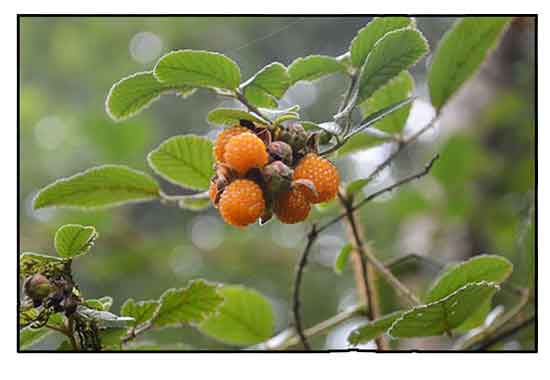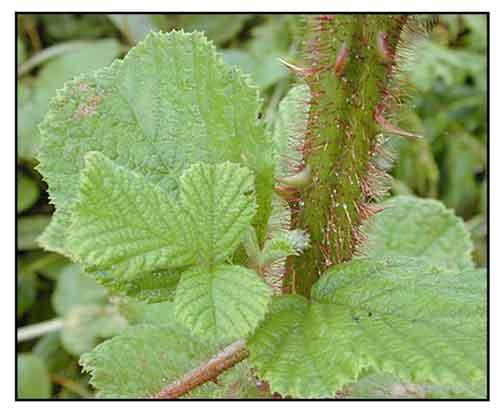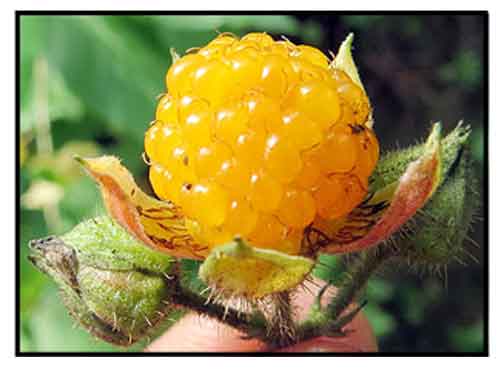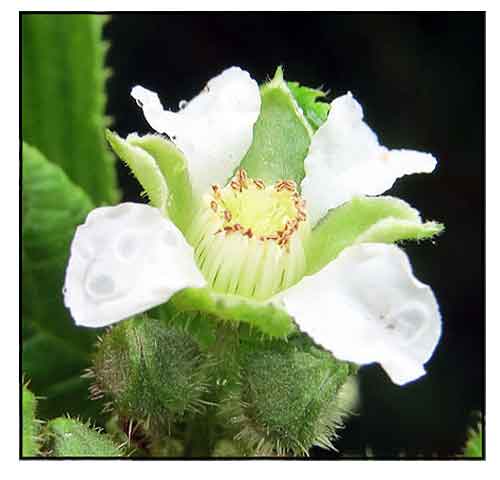 Gen info Gen info
- Rubus ellipticus is an Asian species of thorny fruiting shrub in the rose family Rosaceae.
- The Rubus genus contains between 450-750 species.
- Etymology: The genus name Rubus derives from Latin ruber, meaning "red", the genus of plants generally called brambles. The specific epithet ellipticus derives from Latin, meaning elliptical, referring to the shape of the leaves.
Botany
Rubus ellipticus is a shrub 1–3 m tall. Branchlets purplish brown or brownish, pubescent, with sparse, curved prickles and dense, purplish brown bristles or glandular hairs. Leaves imparipinnate, 3-foliolate; petiole 2–6 cm, petiolule of terminal leaflet 2–3 cm, lateral leaflets subsessile, petiolule and rachis purplish red bristly, pubescent, with minute prickles; stipules linear, 7–11 mm, pubescent, with intermixed glandular hairs; blade of leaflets elliptic or obovate, 4–8(–12) × 3–6(–9) cm, terminal leaflet much larger than lateral leaflets, abaxially densely tomentose, with purplish red bristles along prominent veins, adaxially veins impressed, pubescent along midvein, base rounded, margin unevenly minute sharply serrate, apex acute, abruptly pointed, shallowly cordate, or subtruncate. Inflorescences terminal, dense glomerate racemes, (1.5–)2–4 cm, flowers several to 10 or more, or flowers several in clusters in leaf axils, rarely flowers solitary; rachis and pedicels pubescent, bristly; bracts linear, 5–9 mm, pubescent. Pedicel 4–6 mm. Flowers 1–1.5 cm in diam. Calyx abaxially pubescent, intermixed yellowish tomentose, sparsely bristly; sepals erect, ovate, 4–5(–6) × 2–3(–4) mm, abaxially densely yellowish gray tomentose, apex acute and abruptly pointed. Petals white or pink, spatulate, longer than sepals, margin premorse, densely pubescent, base clawed. Stamens numerous, shorter than petals; filaments broadened and flattened basally. Ovary pubescent; styles glabrous, slightly longer than stamens. Aggregate fruit golden yellow, subglobose, ca. 1 cm in diam., glabrous or drupelets pubescent at apex; pyrenes triangular-ovoid, densely rugulose. (Flora of China)
Distribution
- Native to the Philippines.
- Also native to Assam, China, Himalaya, India, Laos, Myanmar, Nepal, Pakistan, Sri Lanka, Thailand, Tibet, Vietnam. (2)
- In forests and secondary growth, at 1000-2400 m altitude.
- IUCN listed as an Invasive: One of the world's 100 worst
invasive species.
- A pest of forests and pastures. In Hawaii, the plant is reported to form impenetrable thickets, threatening lowland wet forests and native plant species.
 Constituents Constituents
- Phytochemical studies of fruits yielded phenols gallic acid and chlorogenic acid, and flavonoid quercetin. Roots yielded gallic acid (phenol), rutin (flavonoid) and rubusides A-J, sericoside, sericic acid, alpinoside (triterpenoids). (4)
- Nutrient analysis of fruit yielded carbohydrate (86,4%), crude fiber (3.53%), crude protein (4.37%), crude lipid (2.73%), and high energy value (374.0 Kcal).
Moisture content has been reported from 64,4% to 80.6%, while ash ranged from 1.30% to 4,1%. Mineral contents (mg/100g) include Ca (450.1), Mg (118.72), K (680.16), P (1.26), N (700), Na (89.43), Fe (4.249), Zn (12.77), Cu (0.020), Pb (0.02), Mn (1.948), Cr (0.47). Vitamin C has been reported at 4.10 to 44.00 mg/100g in different studies. (5)
- Phytochemical analysis of fruits yielded flavonoids, carbohydrates, steroids, tannins, and phenolic compounds. (see study below) (11)
- Histochemical analysis of root bark was positive for starch, lipids, protein, tannins, alkaloids, saponins, glycosides, mucilage, and calcium oxalate crystals. Phytochemical screening of water, chloroform, and ethanol extracts showed presence of starch, terpenoids, proteins, amino acid, mucilage, alkaloids, anthraquinone glycoside, saponin, and tannins, with absence of steroids and flavonoids. (12)
- Study of roots isolated ten new triterpenoid saponins (1-10), named rubusides A-J, along with 21 known saponins. (see study below) (16)
Properties
- Studies have shown antioxidant, wound healing, antitumor, analgesic, anti-inflammatory, antipyretic, antidiabetic, anti-ulcerogenic properties.
Parts used
Fruits, roots, shoots, bark, leaves.
 Uses Uses
Edibility
- Fruits are edible, sweet to taste.
- Nepal farmers ferment the fruit to produce wine. (3)
- Fruits perishes quickly after plucking from the thorny bush. (3)
Folkloric
- Roots and young shoots used to treat colic pains.
- In traditional medicine, used for fever, diarrhea, stomach pains, skin infections, joint pains, wound healing, diabetes. Used as anti-fertility agent, analgesic, antiepileptic, tonic, etc. (3)
- In Tibet, bark used as renal tonic and antidiuretic. Juices used to treat cough, fever, colic, and sore throat. (3)
 - In Sikim, roots are used to treat stomach pains and headaches; fruits used to treat indigestion. (3) - In Sikim, roots are used to treat stomach pains and headaches; fruits used to treat indigestion. (3)
- Whole plant used to reduce typhoidic fevers. Roots used for fever, diarrhea, stomach problems, wound healing, fractured bones, headaches, urinary tract infections. Fruits used for fever, dysentery, gastralgic, diabetes, wound healing, sore throats, epilepsy, ulcers, constipation. Shoots used for stomach aches, diabetes, colic pains, hypothermia. Bark used for stomach aches, cough, colds, blood disorders, vaginal discharge, diabetes, and as renal tonic and antidiuretic. Aerial parts used for hypothermia. Leaves used for fever, dysentery, stomach pains, diabetes, wound healing, ulcers, and as antifertility. (4)
- In China, traditionally used for diarrhea, dysentery, cough, fever, colic, gastric problems, vomiting, wound healing, pain and fever. Fruits used for indigestion, cholera, heart problems, diabetes, constipation, nausea, abdominal pains. Paste of young fruits consumed as antacid treatment of gastritis, and for diarrhea and dysentery. Fruit juice use for mouth disorders, leukoplakia, cold sores and mouth ulcers. (5)
- In India, fruits and leaves used for diarrhea. Roots taken for rheumatism, ulcers, and skin infections. Fresh tender leaves chewed for tongue sores. (7)
- The Nagas of Manipur use decoction of root bark for fever; also for diarrhea, dysentery, fractured bones, and as abortifacient and emmenagogue. (12)
- In the Himalayas, root decoction used for cough, fever, malaria and stomach ailments. Roots and tender shoots used for colic. Fruit juice used for fever, colic, coughs and sore throat. Inner bark used as renal tonic and antidiuretic, vaginal and seminal discharge, polyuria, micturition during sleep. (13)
Others
- Dye: Fruits yields a bluish-purple dye.
Studies
• Antitumor / Wound Healing / Leaves: Study evaluated the antioxidant, wound healing, and antitumor properties of R. ellipticus leaf methanol extract. Acute oral and dermal toxicity studies showed safety of the ME up to a dose of 2 g/kg. Significant wound healing activity was seen in incision and excision models and Staphylococcus aureus-induced infected models. Treatment prolonged the life span of mice with Ehrlich ascites carcinoma (EAC: 46.76%) and reduced volume of Dalton's ascites (DLA) solid tumors (2.5cm3). (6)
• Anti-Inflammatory / Analgesic/ Antipyretic / Leaves: Study evaluated the anti-inflammatory, analgesic and antipyretic activities of R. ellipticus leaf methanol extract. On acute toxicity testing, no mortality was observed up to 2000 mg/kbw. Doses of 200 and 400 mg/kg showed significant anti-inflammatory, analgesic, and antipyretic activities. There was significant reduction of paw and ear edema compared to indomethacin. The doses also reduced writhing responses and increase latency period in analgesic testing compared to aspirin and morphine. Rectal temperatures of rats were significantly decreased compared to paracetamol. (8)
• Zinc Oxide Nanoparticles / Antibacterial / Antioxidant / Anticancer / Dye Degradation / Fruits: Study reports on the green synthesis of ZnO-nanoparticles (ZnONPs) using aqueous fruit extract of R. ellipticus. The NPs exhibited significant invitro antioxidant activity. Antibacterial and antifungal activity was observed against Bacillus subtilis and Rosellinia necatrix with MICs of 31.2 and 15.62 µg/mL, respectively. Anticancer activity was evidenced by 52.41% A549 cells death (IC50 158.1 µg/mL( at 200 µg/ml concentration of NPs. Photocatalytic activity showed 17.5% degradation of methylene blue. Results suggest potential for wastewater treatment and pharmaceutical and medical applications. (9)
• Antiulcerogenic / Roots: Study evaluated the antiulcerogenic effect of ethanolic root extract of Rubus ellipticus in HCl/ethanol and aspirin plus pylorus ligation models. Results showed reduced ulcer area and ulcer index in HCl/ethanol model, and reduced ulcerative lesions, free and total acidity, and raised pH of gastric juice in aspirin plus pylorus ligation model. (10)
• Antidiabetic / Fruits: Study evaluated the protective effects of R. ellipticus petroleum ether, ethanolic, and aqueous extracts of fruits on glucose tolerance and alloxan-induced diabetes in male wistar albino rats. Acute toxicity testing observed no toxic neurological and behavioral symptoms up to dose of 2000 mg/kg. All extracts exhibited significant antidiabetic effect in both experimental models. (see constituents above) (11)
• Antiproliferative / Antioxidant / Phenolics from Fruits: Study of acidic acetone extract of fruits revealed high total phenolics (899 mg GAE/100 g FW) and flavonoids (433.5 mg CE/100 g FW). The acetone and methanol extracts showed potent antiproliferative activity against human cervical cancer cells (C33A) with EC509 inhibition at 5.04 and 4.9 mg/ml fruit concentration, respectively, with no cytotoxicity to normal PBMC cells. (14)
• Cuprous Oxide Nanoparticles / Antibacterial / Anticancer / Fruits: Study reports on the green synthesis of cuprous oxide nanoparticles (Cu2O-NPs) using aqueous extract of R. ellipticus fruits. The
Cu2O-NPs showed significantly lower antioxidant activity than the aqueous fruit extract. They showed higher antimicrobial activity against B. subtilis, Rosellinia necatrix, S. aureus, E. coli, P. aeruginosa, and Fusarium oxysporum. The Ru-Cux-O-NPs showed anticancer activity against colon cancer cell lines (SW480 and SW620) at 100 g/mL concentration. Results suggest good antimicrobial and anticancer properties with low toxicity. (15)
• α-
Glucosidase Inhibitory Activity / Roots: Study of roots isolated ten new triterpenoid saponins (1-10), named rubusides A-J, along with 21 known saponins. The compounds demonstrated inhibitory activities against α-glucosidase with IC50s in range of 0.65 to 3.09 mM. (16)
• Silver Nanoparticles / Antibacterial / Roots: Study reports on the low cost, green synthesis of silver nanoparticles using aqueous root extracts of R. ellipticus as capping and stabilizing agent. The AgNPs showed better DPPH radical scavenging activity with IC50 13.83 µg/ml compared to RERE with IC50 of 15.86 µg/mL. The AgNPs showed high zones of inhibition on agar well diffusion method against E. faecalis, E. coli, S. aureus, and K. pneumonia. (17)
• Anti-Inflammatory / No Membrane Stabilizing Activity / Roots: Study evaluated the anti-inflammatory and membrane stabilizing property of ethanolic root extract of R. ellipticus in rats. Anti-inflammatory activity was evidenced by significant (p<0.01, p<0.001) reduction of edema induced by carrageenan in rats at doses of 250 and 500 mg/kg. The extract did not show membrane stabilizing activity, failing to significantly reduce levels of hemolysis of RBC exposed to hypotonic solution. (18)
• Antifertility / Roots: Study evaluated ten indigenous plants for antifertility activity in albino rats. Results showed 90% ethanolic extract of three plants, viz., Rubus ellipticus roots, Crateva nurvala bark, and Terminalia bellirica bark showed 60-66% antifertility activity when administered orally at 250 mg/kg dose in days 1-7 of pregnancy. (20)
Availability
Wild-crafted.
Seeds in the cybermarket. |

![]()





 Uses
Uses
